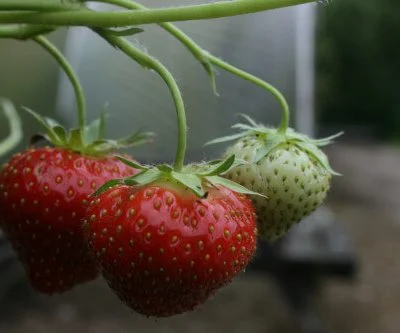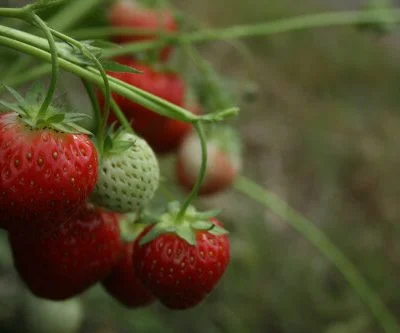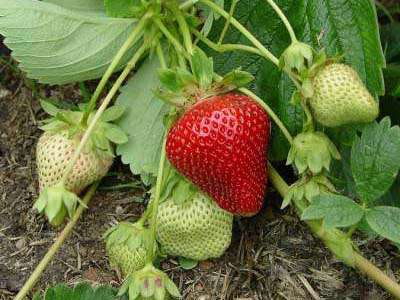Your basket is currently empty!
Perfection in Strawberries
The number one priority for the vast majority of gardeners when growing strawberries is that of flavour, and most importantly, sweetness. We all crave that sugary sublime sweetness that comes from the perfect berry, it’s what we set out to achieve. There aren’t many of us that appreciate tart strawberries – maybe if you’re making jams or cooking with them, but not to eat fresh.
Order from our strawberry plants.
Sugar levels in fresh fruit are measured by brix method – the higher the brix count then the more sugars there are within the fruit. Obtaining the greatest brix count is a surprisingly complex procedure. And it isn’t. as you might assume, all down to variety either. True some varieties taste better than others, and true, some naturally have more sweetness. But variety choice isn’t the only factor involved here – cultivation plays a big part too. So in order to harvest the perfect, sweetest strawberry, you need to make sure a number of factors come together.
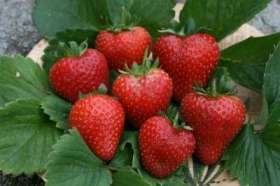
Cultivation is key
Climate, substrate, feed, siting and water are all important. It’s the perfect combination in growing strawberry plants that develops the perfect strawberry.
Siting
Strawberries can fruit surprisingly well with some shade – but the flavour won’t develop to the same extent as those grown in the sun. Sun it is that develops sugar levels in the berries – so make sure your plants get lots, and lots of it. A full sun position is the ideal and a fairly open siting too so as the sun moves around it is still reaching the plant. Make sure the plants aren’t grown too close together, nor that there is immediate competition for light – and sunlight – from neighbouring plants and bushes.
If your plants are growing vigorously consider removing some of the foliage – up to a third is fine without proving detrimental to the plants. This has the effect of making sure the developing fruits are in the sunshine.
The soil
I must have sampled thousands of strawberries on the nursery over the many years we have grown them, fruits grown in any number of ways and methods. And almost always the best tasting ones come from those in the natural soil – plants grown in pots of standard proprietary potting compost yield berries that are inferior in taste. Which is not to say you should not grow and enjoy strawberries in containers – millions do and the taste is fine, probably still better than those you might buy from the supermarket …… but if you want the perfect strawberry try to grow them in the ground. And if you are growing them in pots of whatever type why not try a loam based compost or add some sterilized loam to the potting mix, it can make the world of difference to the taste of your strawberries. Potting compost seems to make the fruits a little ‘sharp’ and lacking in the rosy roundness of well flavoured fruits. Still nice to eat, but not perfect.
Feeding
You will definitely want to feed your strawberries in order to help the plants develop the flavour; starving plants, even if they may look healthy enough, will not yield well flavoured fruits. The choice of fertilizer here is key – you want one with lots of potassium because it has been proven than plants fed with a potassium rich feed develop more sugar and a better flavour! Tomato feed [Tomorite or similar] is the most well known fertilizer within this category, it’s easy to find and use. But there are others too that maybe your local stockist can recommend.
Timing is key.
You want to start feeding for flavour just as the flowers begin to show. The fruits will set and already be present in a very juvenile stage just a few days later so you want to make sure the plant is already taking up that lovely potassium rich feed right at the start as the fruits begin to swell. Apply once again 2 weeks later, and again 2 weeks after that. This same feed can be applied to plants grown in containers or growbags too.
It is important that you select a balanced NPK fertilizer, or growmore, to feed the plants for growth and health, early in the season, and after the plants have finished fruiting, to buold strength in the plant for next year.
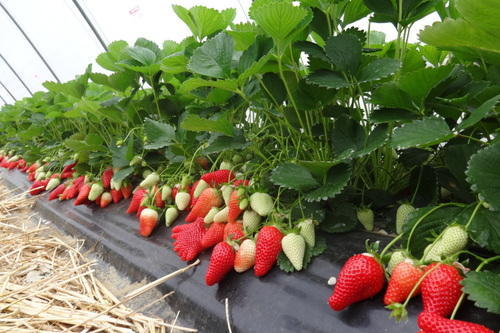
Strawberry Plants Irrigation
In order that the plants effectively take up the nutrients, convert the sunlight into sugars, and are able to swell the berries to their optimum sizes, the plants must never even think of drying out. This is especially important if you have as I suggested been able to give the plants a position with maximum sun exposure. The area around the plants will be free of debris and open, and that baking sun will soon dry things out alarmingly quickly. You must counteract this with regular and ample watering. Soak the soil around the base of the plant with a watering can, preferably early in the morning, or in the evening. Take care not to splash the fruits with mud. This should be done daily if it has not rained, until the fruits are fully formed.
Now you have ensured your strawberries are not only sweet and well flavoured, but plumpalicious too!
Harvesting time is key
You’ve done all the hard work, so to experience your strawberries at their absolute best you need to understand what is the optimum time to savour them. You see if you pick too soon the flavour still won’t have developed to it’s absolute peak. The berries may be colouring up but if they are too pale or not coloured evenly then it is too soon. They may still be a little sour. Conversely, berries that have been hanging on the plant for too long in the hot sun, and become too dark in colour, will have a flavour that has become wine-like, overbaked. I find they are still quite edible like that but hardly at their peak of perfection. Save them for jam making, or a pie perhaps. The fruits should be evenly coloured, a good bright red – only then are they perfect for eating.
Variety choice – The best sweetest strawberry plants
Of course probably the single most influential factor in determining the taste of your crop is still that of variety choice. You can make a poorly tasting variety more palatable by employing these growing techniques, but it may never attain perfection. You can similarly grow the best tasting variety in the world but if it is cultivated poorly it will still disappoint. So you combination of these varieties, and the growing hints described above, is your ticket to strawberry tasting heaven!
This list of recommendations is not absolute, and is based on my opinion and observations of many years’ strawberry growing. Do not necessarily discount other varieties in our catalogue which may still have a good flavour and other qualities as well, depending on intended usage and personal preference. Almost inevitably the older varieties predominate here, showing the gap in class when it comes to a really stringent taste-test such as this. But a few modern varieties do make the list too, bringing with them added performance superiority.
ROSIE Strawberry Plants
This is an early variety – and I am only going to grant two earlies entry to this list. The earlier strawberries so often seem to have a brisk taste – even the well flavoured ones. I often think they taste so delicious because they are the first ones! Compared to some of the best maincrop varieties then maybe in the main they aren’t so good. Rosie is probably the sweetest early variety we grow. It’s an all round easy to grow variety, vigorous, but not unruly, and a good cropped for 3-5 years. Ripening early June, it suits standard outdoor cropping, or pots. Highly recommended, and has a good reputation amongst strawberry growing professionals.
ELVIRA Strawberry Plants
The second early variety in this list, a European variety of several years standing that nevertheless remains useful. It’s a tall, rangy plant that sometimes gets mildew but isn’t a real martyr to disease. It is often listed for use under cover, or forcing, but it grows just fine outdoors too. The fruits are fairly elongated, a good vermillion colour and have plenty of juice along with a really good mild non-acid taste. A second early rather than a first early that can be cloched, and is usually showing well ripened fruits by June.
PEGASUS Strawberry Plants
A modern day variety with a well decent flavour – hurrah! Pegasus crops mid-late season, providing a good bridging gap between the true mid seasoners and the late maincrop varieties. The fruits are even, well coloured and the plant has good dark leaves. Little disease of any consequence. The flavour is mild and almost entirely sweet with a tempting pinky red inner flesh which is quite soft and juicy, definitely not as firmly textured as many modern varieties. Moderately vigorous grower, easy to manage.
ROYAL SOVEREIGN Strawberry Plants
It had to be here, the variety widely known as the most gorgeously flavoured British strawberry of all time ……. But it’s not a variety any professional could really recommend on any other count and it’s certainly not a variety to take on lightly. It isn’t at all easy to grow well and amateurs will struggle with it. Disease is the main problem – the plants will start to grow quite vigorously and show a lot of promising growth but soon enough the big crinkly leaves start to curl, alarming blotches and spots start to appear [‘strawberry measles’ a customer once memorably described it as] and the fruits too may get mildew and or botrytis mould. Definitely not a variety for organic growing, you need a rigorous fungicidal spray programme to grow it satisfactorily and even then a few gremlins may appear. Avoid over feeding which makes things worse. It’s not a bad cropper, the fruits are fairly pale in colour, soft and juicy and the flavour does indeed bring sighs of satisfaction. But is it all worth it? You decide. Fruits ripen early-mid season.
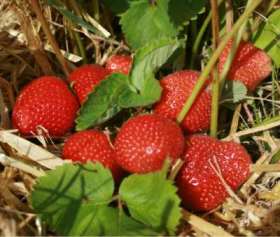
TALISMAN
An old timer, and a true Brit strawberry. The fruits are no more than medium sized and ripen quite dark so it’s important to catch them at the right stage. A mid to late season variety, with dark foliage and quite easy to grow with no real snags or drawbacks. The flavour is virtually perfection, with all the subtleties and a true strawberry aroma lacking in todays supermarket samples, it’s also quite soft in texture, unlike the granite zeppelins favoured by commercial growers. Has been grown for over 100 years yet surprisingly fault free. Moderate yield.
FLORENCE Strawberry Plants
A little over 10 years of age but still comparatively modern, yet this late maincrop variety always does well in taste tests and is a predominant farm shop and PYO variety that is well liked. Easy to manage and easy to grow with little disease, the even rounded fruits have a very good taste and it seems to thrive on all soils. Florence is a late main season variety and a season extended; quite frost resistant so good for the North too.
GORELLA Strawberry Plants
A well known variety from the late 1970’s and 1980’s that was often disparaged at the time because it is a variety from the Continent, this at a time when only English varieties were held in esteem, Gorella seems to have stood the test of time and probably deserves re-evaluation. A lot of the European varieties of that era were decidedly lacking in flavour but Gorella was different and I have always liked the taste. A second early to maincrop variety with a tidy close habit, and somewhat ‘wedge shaped’ fruits [handbags my Ma would call them!] which doesn’t bother me but maybe to be avoided if you like perfection of form in your strawberries. Sometimes gets a little mildew/botrytis but largely good to grow and easy too; I like it for pots or open ground growing alike. Well worth considering.
RHAPSODY Strawberry Plants
Scotlands finest ever variety and carries with it useful frost resistance, the leaves are pale and crinkly, and the flowers set well in all weathers. The fruits are usually long in shape and ripen late summer season. The texture is a little firm sometimes but the flavour is sensational – deep, rich, aromatic and pure essence-of-strawberry! Must be tried and a great season extender. A variety we championed many years ago which has proved to be enduringly popular and the best late main season variety by far for home growing.
BRENDA Strawberry Plants
Popular in the Wisbech area in the 1960’s and fondly remembered, it was rescued from near oblivion about 10 years ago. Brenda makes a dark leaved compact plant with quite dark red fruits which have always been known to a true old-time strawberry flavour lacking in todays modern newcomers. Late season ripening, crops are variable these days, sometimes abundant and sometimes lighter, so take it as it comes but few strawberries have a better taste. July ripening.
AROMEL Strawberry Plants
My pick for an Autumn fruiting or ‘perpetua’ variety. Aromel has been grown since the 1970’s when it was easily the most popular in it’s class. It has endured and maintains a loyal following of growers today, even as it has been superceded by a raft of largely flavour-free newcomers. Aromel is quite a bushy grower, unusual in the Autumn fruiting varieties. It may crop at any time from July onwards but the bulk of the yield ripens late August and September. Cropping can continue into October or later if the weather is not too cold and you can accentuate this by placing cloches over the plants. The fruits are medium to large, bright deep red with a paler juicy tender interior. The taste is sublime and entirely irresistible, just ask anyone that has grown it and that’s why it has kept it’s place all these years.
Other varieties of Strawberry Plants deserving of mention: Norfolk Nectar, Chapelaine, Cambridge Prizewinner, Sweetheart, Cambridge Favourite, Eros, Mae, Rabunda, Korona.




